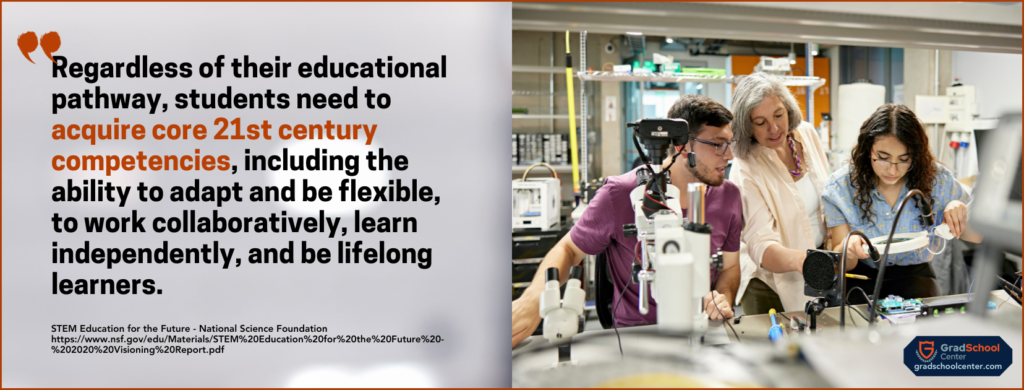10 Biggest Innovations in STEM Graduate Programs

Find your perfect college degree
Science, Technology, Engineering, and Math—the STEM fields, are the most critical subjects in today’s interconnected global society, from healthcare to communication. There wouldn’t be many discoveries or advancements today if it weren’t for these fields that could boost productivity, save lives, or enhance the economy.

The workforce demand for STEM fields is increasing and is vastly evolving. As a result, more and more universities are offering pathways to meet these demands. But still, some universities stand out as the best schools for obtaining a STEM major, mainly because these schools are at the forefront of developing new technologies.
Moreover, these colleges and universities have world-class research facilities and student opportunities that allow undergraduates to continue their education. Here is a list of some of the top STEM graduate schools.
How to Choose the Best STEM Graduate Program
STEM is an interdisciplinary field that has become a driving force behind innovation, shaping the way we live, work, and understand the world. There are several majors and degree programs under the STEM umbrella, from agricultural technology to computer science to biomedical engineering. There’s a lot to choose from, and it will often leave you undecided on which graduate STEM major best complements your undergraduate degree.
First off, here’s a quick overview of the STEM fields:
- Science: Science is the study of the natural world through research and experimentation, encompassing various topics such as biology, Chemistry, Physics, Environmental Sciences, Astronomy, and Geology.
- Technology: This involves applying scientific knowledge to practical applications, addressing issues and challenges, and is ideal for those who enjoy working hands-on and problem-solving.
- Engineering: Closely related to the other fields, engineering is the study of science and mathematics for building structures and machinery, focusing on problem-solving and problem-solving. Major types include aerospace, automotive, chemical, civil, electrical, mechanical, and biology-related fields like biomedical or environmental engineering.
- Mathematics: This field studies the numbers, guiding scientific and technical disciplines. It fosters reason, abstract thinking, problem analysis, creativity, and problem-solving.
While others continue and build on what they’ve learned, others pursue graduate programs to explore another STEM field. But before anything else, you must remember that these fields require high analytical thinking and intellectual rigor and are strictly not for the faint-hearted.
Define Your Goals
Before immersing in a STEM field, you should know your goals. You don’t want to spend months on end studying for an expensive graduate degree only to decide in the middle of your graduate program that it’s not for you. Remember that the average graduate degree costs $65,134. If you want to study at one of the best graduate schools for STEM, you should expect to pay more than this average.
Think back to the courses you took as an undergraduate student. Reflect on which of those courses really piqued your interest and engaged you the most. You can also determine what major best suits you if you assess your hobbies and reflect on what piqued your interest the most, whether that be learning the intricacies of coding, doing experiments in a biology lab, or working through discrete mathematics.
For instance, a computer science or electrical engineering graduate could be a good choice if you want to contribute to cutting-edge technologies. On the other hand, if your motivation stems from a desire to tackle global health issues, a public health or biomedical sciences program may better suit your goals.
Some STEM students like the intricacies and variety of majors that require a multidisciplinary approach. If you’re one of these students, you should choose a STEM field integrating multiple majors for a well-rounded skill set. For example, bioinformatics or environmental engineering often combine biology, computer science, and engineering elements to address complex issues.
Once you’ve assessed your goals and interests, you’ll find what you need from a graduate program.
Know Your Limits
STEM is one of the hardest majors to deal with because of its diversity and intricacies. These fields have a demanding workplace environment. Those unprepared for the challenge and the field’s competitiveness are likely to fail and later choose another career path. It will cost you a lot—physically, mentally, and financially.
It’s essential to know your limits before you start your application process in any STEM school. Think of what would be a deal-breaker for you.
Here are a few guideline questions:
- Are you prepared for a rigorous workload that may include extensive lab work, research projects, and complex problem-solving?
- Can you manage your time effectively to balance coursework, research, and potentially teaching responsibilities?
- Can you handle the long-term commitment required for completing a thesis or dissertation, which often involves overcoming unforeseen challenges and setbacks?
- Are you comfortable working collaboratively with other researchers and students from diverse backgrounds?
- Are you aware of the financial commitments associated with graduate education, including tuition, living expenses, and potential research-related costs? Are you resilient in the face of setbacks and challenges inherent in scientific research and problem-solving?
- Are you genuinely passionate about your chosen STEM field, and does the prospect of contributing to advancements in that area drive your motivation?
Others might feel like defining limits will erase the possibility of them ever being ready for graduate school, and that’s why they plunge into demanding coursework without thinking much. Knowing your limits will help you identify which graduate school best fits your lifestyle.
You shouldn’t enroll in a highly competitive school if you can’t cope with stress and competition. The top schools producing world-changing innovations require competitive and resilient students. You might not be a good fit for any STEM program if you’re not a team player.
Selecting a Graduate Program
After carefully evaluating your goals and interests and defining your limits, you’re set to find the best graduate program.
The first step to selecting which program or graduate school suits you is learning the admission requirements, graduation time, cost, and application and acceptance process details. Finding a place and organization that best fits your professional and personal objectives and constraints should be a priority while researching programs.
Next, delve into the faculty profiles, ongoing research projects, and resources available at various institutions. This exploration will offer you a glimpse into the academic environment and the opportunities for hands-on experience, both of which are vital for a fruitful STEM graduate education.
You should also place a high value on the school’s geographic location or the social and environmental conditions. In most cases, you have to relocate. Assess the cost of living in the area. Some regions may have a higher cost of living, impacting your overall budget and financial well-being during your studies.
Connect with industry experts and former students in the field you want to pursue. These connections can provide insightful information about the program’s practical components, possible job pathways, and experience. To obtain a more comprehensive viewpoint, consider attending seminars, conferences, or networking with professionals via online forums.
As your graduate studies advance, have an open mind about changing your original plans. Due to the dynamic nature of STEM areas, you might discover previously unconsidered prospects. As you navigate the fascinating and constantly changing world of STEM graduate education, remember to be adaptable, interested, and enjoy the learning process.
10 Biggest Innovations in STEM Graduate Programs
Massachusetts Institute of Technology

Massachusetts Institute of Technology (MIT) is a world-renowned institution for STEM programs at all degree levels. You probably won’t see a list of top STEM schools without mentioning MIT. MIT offers several STEM graduate programs, such as Chemical Engineering, Computational and Systems Biology, Computational Science and Engineering, Technology and Policy, and more.
If you aspire to pursue a graduate degree at MIT, you need to consider a few things. For one, although not an Ivy League school, MIT has a very stringent admission process. Its admission rate for graduate degrees is 10.6%. As an applicant, you need to stand out. You should do well academically, display your love of learning, and have remarkable accomplishments in your chosen profession. To further improve your chances of getting into MIT, emphasize your unique experiences, participate in worthwhile extracurricular activities, and write a strong application.
Another consideration is the cost of learning. MIT boasts one of the highest tuition fees, which is justified by its intense academics and research and networking opportunities.
Harvard University

Harvard University is one of the eight Ivy League schools in the United States. Undoubtedly, obtaining a degree in this university will help you land better jobs in your desired field—employers in large-scale companies love hiring Ivy League graduates for their knowledge and competence. After all, Harvard is the forerunner of scientific education and engaged cultural activities.
Harvard University has several schools offering a wide range of STEM graduate degrees. The university emphasizes high-end research, particularly in computer science and biology. Nonetheless, math and engineering are also prioritized by the students. Another standout feature of Harvard is its several opportunities that help the most talented students graduate debt-free.
Harvard is also a competitive school, with an acceptance rate of below 5%. Ultimately, you must go above and beyond if you want a spot at Harvard, especially in its STEM degrees. For other prestigious schools, a 4.0 is impressive. But in Harvard, the average GPA of their accepted students is 4.18!
You need more than just high GPAs to increase your chances of an acceptance letter. You should also prove that you’ve worked hard in extracurricular activities, been involved in community and leadership roles, and secured glowing recommendation letters.
Stanford University

Stanford University is another world-class institution renowned for its robust academic programs, award-winning faculty, and innovative research opportunities. STEM graduate students at Stanford engage in discussions about learning and equity in science education through workshops and volunteer work. You can choose from a pool of STEM graduate majors.
Each graduate program ensures that graduate students develop leadership, mentorship, and community understanding skills that will lead to competitive careers. Among its most innovative graduate programs is the study of Stem Cell Biology and Regenerative Medicine. Moreover, Stanford boasts one of the highest rates of student satisfaction and various opportunities for graduates to impact the national economy.
The university spends millions of dollars annually to improve facilities, finance biology, medicine, and technology instruction, and conduct research in these fields. The university’s strategic location near Silicon Valley allows its students to keep pace with technological advancements.
California Institute of Technology

California Institute of Technology (CalTech) is a leading university in STEM, focusing on research and education to advance human knowledge and improve society. CalTech boasts many Nobel Prize winner alums. The university also invented the first silicon chip, discovered gravitational waves, developed the pH meter, and much more.
Aspiring graduate students can choose from several STEM majors, from chemical engineering to environmental sciences and more. As a research-intensive institution, CalTech offers a unique approach that encourages students to strive hard to succeed and overcome challenges.
As with other research-focused institutions, CalTech has a selective admissions process, although it’s hard to pinpoint the exact acceptance rate at CalTech, which is difficult since the school does not publicize it. But to provide insight into how hard it is to get accepted into CalTech, you must be in the top 5% of your class. Although there’s no GPA requirement, admitted graduate students have a GPA of 3.5 on a 4.0 scale.
University of California Berkeley

The University of California Berkeley is a little bit of everything, known for its prominence in offering STEM majors (particularly in the science and engineering departments) and its award-winning faculty. Former faculty members include J.R. Oppenheimer, known for developing the atomic bomb, and Ernest Lawrence, inventor of the cyclotron, crucial in discovering 16 elements at Berkeley Lab.
The Berkeley Graduate Division offers over 100 degree programs with high-ranking doctorate-level majors. However, because UC Berkeley has set an incredibly high standard in every field, admission to its programs requires extraneous efforts. Berkeley is known for rejecting outstanding STEM applications because they lack visual or performing arts coursework.
UC Berkeley’s competitive STEM programs require students with research experience and strong application essays, each requiring four personal insight questions and four distinct stories, to secure admission.
Georgia Institute of Technology

Georgia Institute of Technology (Georgia Tech) is a prominent technical and research institute in the country. Headquartered in Atlanta, it has a history extending to France, Ireland, and the Far East in China and Singapore. Although Georgia Tech offers several STEM graduate degrees, they are mostly applauded for their focus on engineering. It invests in research and technology, offers international exchange programs, and primarily focuses on Mechanical and Industrial Engineering.
Georgia Tech consistently arranges summer programs, exchanges, overseas internships, and other initiatives. It also strongly emphasizes research and provides students with all sorts of programs that integrate improved technology. Even humanities degrees converge with STEM fields. It is a demanding and inspiring educational setting for students who aspire to be specialists in both fields.
Its admission rate may not be as competitive as other STEM-focused schools, but its academic competitiveness and rigor are undeniably high. Georgia Tech actively encourages students to engage in groundbreaking research projects, allowing them to work alongside leading experts in their respective fields.
Illinois Institute Of Technology

Illinois Institute Of Technology is a research-focused institution offering a range of STEM programs and majors, focusing mainly on technology and scientific research. Students are trained to excel in various STEM skills, emphasizing engineering in Health, Energy, Security, and Water.
IIT also offers international students four STEM business programs, with popular programs including electrical engineering, mechanical engineering, and computer science. The institution also has a thriving campus environment. Beyond academics, Illinois Tech houses over 100 STEM-designated student organizations that allow students to boost their networking and creative abilities.
Illinois Tech’s grad school has a more lenient admissions process compared to other research-intensive universities. It gives undergrads who weren’t at the top of their classes a chance to pursue a STEM field. The focus on inclusive admissions enhances the quality of education by attracting talented individuals who contribute to a diverse and collaborative learning environment.
Texas A&M University

Texas A&M University (TAMU) is a top public research university that serves as a gateway for students seeking affordable STEM programs. According to the Hispanic Outlook on Education Magazine, TAMU is among the leading institutions in the US for granting graduate degrees to Hispanic/Latino students. This university is also well known for its outstanding academics, state-of-the-art research facilities, and cooperative research projects.
The Graduate and Professional School at TAMU offers a range of STEM degrees, particularly in engineering, for students who want to gain an advantage in today’s competitive job market. Several online and on-campus degrees at TAMU provide ample opportunities to pursue a rigorous academic program without sacrificing much of your current lifestyle.
Moreover, TAMU’s Aggie STEM offers students in the field the chance to explore opportunities for better career and skill development.
Worcester Polytechnic Institute

In addition to being known for its excellent undergraduate STEM programs, Worcester Polytechnic Institute also offers several STEM graduate degrees. WPI seeks to improve student performance in STEM courses and STEM major graduation rates, with a particular emphasis on diversifying the student body and raising the achievement levels of underrepresented students.
WPI’s STEM offers experienced faculty members who are abreast of research findings and use effective pedagogy and models in STEM teaching and learning. These faculty members also teach various Online Professional Development Courses and Training to help students enrolled in full degree programs develop their industry skills further. Graduate students pursuing any courses and training will sign up for individual classes, group projects, practical learning experiences, and other projects.
WPI aims to produce engineers who are focused, are critical thinkers, and are experts in mechanical, electrical, and computer science. Other fields included in the graduate school are physical sciences and mathematics.
Stevens Institute Of Technology

Stevens Institute Of Technology was established by various inventors and visionaries dedicated to providing science education to Americans. Over the years, SIT has become one of the top-performing undergraduate and graduate STEM education schools. It has two national research centers, the Maritime Security Center (MSC) and the Systems Engineering Research Center (SERC), focusing on innovations, security, and engineering.
SIT strictly emphasizes sustainability in all its STEM programs. Students at SIT are immersed in a curriculum that not only provides technical knowledge but also instills a profound appreciation of the environmental effect of their work, from inventing eco-friendly technology to implementing sustainable engineering practices. This all-encompassing strategy aims to generate graduates who are responsible contributors to a more sustainable future and skilled in their particular STEM disciplines.
Graduate students have various opportunities to participate in classes on entrepreneurship and how to launch their own STEM group or firm, as well as internships. Due to the tight engagement between the student body and the school administration, team-based and individual assignments are offered.
Additional Resources:




